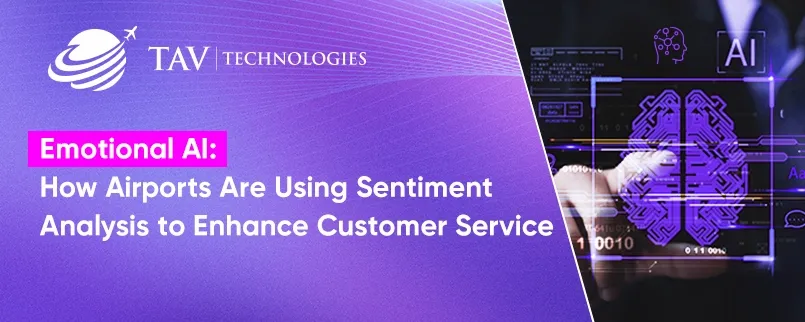
May 2025
Airports are dynamic environments where thousands of journeys begin, pause, or end each day. In addition to ensuring safety and operational efficiency, enhancing passenger satisfaction has become a critical focus. To meet growing expectations, airports are increasingly turning to Emotional AI—a technology that enables systems to detect and interpret human emotions in real time.
By analyzing emotional cues from facial expressions, speech, gestures, and text, Emotional AI—powered by sentiment analysis—is helping airports create more personalized and responsive travel experiences.
What is Emotional AI and How Does It Work?
Emotional AI, or affective computing, combines artificial intelligence techniques such as machine learning, computer vision, and natural language processing to evaluate emotional signals. This technology can interpret spoken or written feedback, facial expressions, or vocal tone to understand how passengers are feeling at different touchpoints in the airport journey.
Instead of relying solely on post-flight surveys or service counters, airports are now able to collect real-time feedback—capturing passengers’ emotions while they’re still on-site. This enables faster reactions to dissatisfaction, reduces stress points, and strengthens trust in the overall airport experience.
Sentiment Analysis in Action: Real-Time Passenger Feedback
Sentiment analysis is at the core of Emotional AI implementations. It processes qualitative data—such as open-text responses or verbal comments—to determine if the underlying emotion is positive, negative, or neutral.
For example, digital kiosks or mobile apps can prompt travelers to share quick feedback during their journey. Algorithms then analyze tone, language, and keywords to identify signs of frustration, confusion, or satisfaction. In other cases, AI-enabled cameras can anonymously interpret facial expressions to gauge crowd mood in terminal areas.
This emotional insight provides a continuous feedback loop that allows airport staff to adjust operations proactively—rather than reactively.
Improving the Passenger Journey Through Emotional Insights
When travelers feel acknowledged and supported, even minor inconveniences become easier to tolerate. Emotional AI enables timely service interventions that can make a significant difference. If sentiment data indicates increasing frustration near security checkpoints or boarding gates, additional staff can be dispatched, queue information can be updated, or relevant notifications can be sent to passengers.
Digital signage can also respond dynamically to negative sentiment, offering helpful information, updates, or even incentives like discount codes to ease the stress of delays. These small but meaningful gestures contribute to a smoother, more empathetic airport journey.
Emotional Data Meets Operational Intelligence
Beyond customer service, emotional data supports broader airport operations. It can reveal patterns that are not always evident through traditional metrics. For instance, sentiment analysis may highlight that a specific terminal consistently generates negative feelings during peak hours, prompting an evaluation of layout, lighting, or staffing levels.
Moreover, combining emotional insights with predictive analytics helps anticipate passenger needs. Historical trends—such as increased stress during holiday travel or due to weather disruptions—can guide proactive resource allocation. This fusion of emotion and prediction results in smarter, more resilient airport operations.
Ethical Use and Data Privacy
As with all AI-based technologies, the use of emotional data must be approached with transparency and respect for privacy. Emotional AI systems in airports are typically designed to ensure that data is anonymized, securely stored, and used solely for service improvement purposes.
Passengers should always be informed about when and how their data is collected, and ideally be given the option to opt in or out. Responsible use of technology is essential for maintaining passenger trust while embracing innovation.
When Airports Listen: Designing Journeys with Emotional Intelligence
Modern airports are evolving into experience-driven spaces where understanding passenger emotions is just as important as managing logistics. Emotional AI enables a shift from standardized service models to personalized care by identifying how travelers feel in real time. This shift fosters a more human-centric environment—one that anticipates needs, responds to stressors quickly, and creates positive emotional touchpoints throughout the journey.
By integrating emotion-aware systems into daily operations, airports can offer not only functional efficiency but also a sense of reassurance, calm, and connection. As emotional intelligence becomes embedded in airport infrastructure, travel experiences become smoother, more intuitive, and ultimately more memorable.
